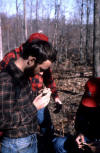

Back to: FLINT TYPES
(up-dated 24/Apr./2016




Nick hefts a large
hammerstone.

It's not hard to see
that we had attended the St. Louis Cardinals/ New York Mets game, the night
before.
Here's some raw, colorful, Mill Creek. It's rind is like Cornthall, which is often found with Mill Creek.
This is some heated Mill Creek. It's color is much rarer than the regular Mill Creek, used to make Mississippian hoes and spades. The blank on the left, is very grainy and heat-treating hasn't helped much. The one on the right is pretty glossy and should work well.
This is the more typical Mill Creek. The left specimen is some of the finer grade, well suited to Mississippian agricultural tools. The right specimen, shows the somewhat typical fractures and cortex of this type. Often Mill Creek will have very poor chert running down the center of the nodule and, sometimes, it can be broken in half, so 2 tools can be made from the same nodule. Note that Mill Creek is a tabular chert. This makes it more adaptable to agricultural tools. Also, Mill Creek is a very tough chert which makes it more adaptable to the manufacture of agricultural tools. Don't give up on Mill Creek, even though it appears to be fractured. Often, the fractures are healed and the chert is still knappable.
From Koldehoff and Wagner's " The Archaeology and History of Horseshoe Lake, Alexander County, Illinois".
"Mill Creek has been attributed to the Salem limestone formation (Lopinot and Butler 1981 and May 1984) and/or the Ullin limestone formation which underlies Salem (Nelson et al 1995). Because Mill Creek resides in residuum, it could be derived from either formation".

For more information, check out the Parkland College CHERT TYPES pages.